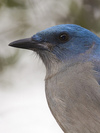Genus Aphelocoma

Western Scrub-Jay - The Western Scrub-Jay , is a species of scrub-jay native to western North America. It ranges from southern Washington to central Texas and central Mexico. It comprises three distinct subspecies groups, all of which may be separate species. They are California Scrub-Jay , Woodhouse's Scrub-Jay , and Sumichrast's Scrub-Jay . The Western Scrub-Jay was once lumped with the Island Scrub-Jay and the Florida Scrub-Jay; the taxon was then called, simply, the Scrub Jay. The Western Scrub-Jay is nonmigratory and can be found in urban areas, where it can become tame and will come to bird feeders. While many refer to scrub-jays as "blue jays", the Blue Jay is a different species of bird entirely. In recent years, the California Scrub-Jay has expanded its range north into the Puget Sound region of Washington.
Florida Scrub-Jay - It is 28 cm long, and weighs 75–85 g . It has a strong black bill, blue head and nape without a crest, a whitish forehead and supercilium, blue bib, blue wings, grayish underparts, gray back, long blue tail, black legs and feet.
Santa Cruz Jay - Santa Cruz Island is run as a preserve, partly by The Nature Conservancy and partly by Channel Islands National Park. The Island Jay can often be seen right at Prisoner's Cove, where many of the boats visiting the Island drop off and pick up passengers. This species is plentiful; it is classed as near-threatened by the IUCN mainly to reflect that a disaster, disease, or invasive species could quickly kill off the thriving population as it is limited to a single island. The Island Scrub-jay is not known to have occurred anywhere else historically, and no fossil remains have been found on the well-researched neighboring islands .
Mexican Jay - The Mexican Jay, Aphelocoma ultramarina, formerly known as the Gray-breasted Jay, is a New World jay native to the Sierra Madre Oriental, Sierra Madre Occidental, and Transvolcanic Belt of Mexico. It reaches north to eastern Arizona, western New Mexico and western Texas in the United States. Its preferred habitat is montane pine-oak forest.
Unicolored Jay - The Unicolored Jay is an Aphelocoma jay native to cloud forests of northwestern Central America and southern and southeastern Mexico, from central Honduras west to central Guerrero, southern Veracruz and extreme southern San Luis Potosi. It is apparently a basal member of its genus .


